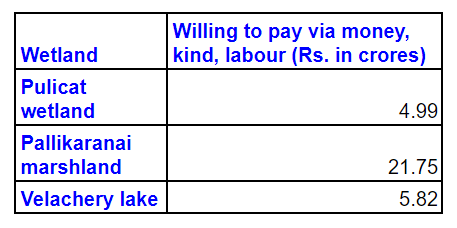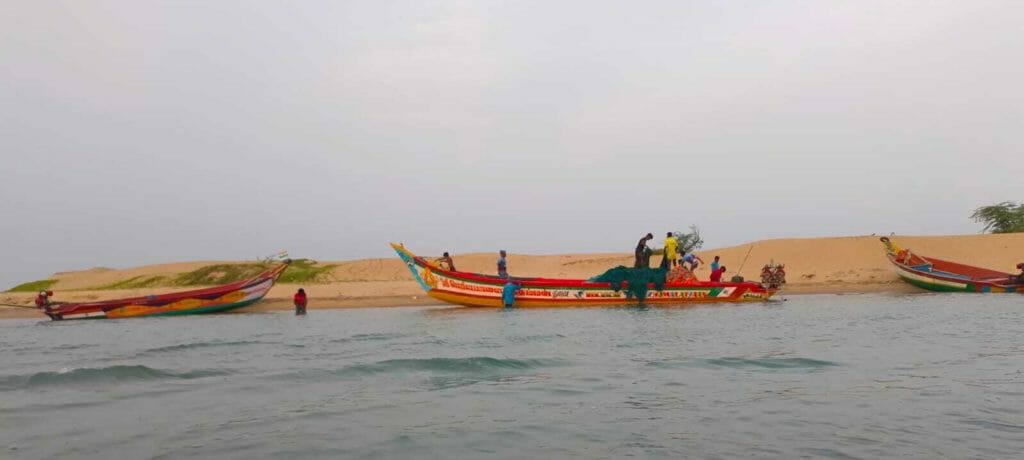“We used to get 1000-2000 kilograms of prawns and other fish in a day around 15 years ago. Now, we are able to catch only 150-200 kilograms of fish per day,” says Raj Kamal, the coordinator of Save Pulicat Movement, an effort to protect the Pulicat wetlands, one of the oldest wetlands in Chennai. “When our wetlands were clean, we used to make even Rs. 50,000 a month. Now it is just a paltry sum. We are forced to pay this price because industries and other agents pollute our waters.”
Wetlands in Chennai provide more than just a living to the local folks. They are home to different flora and fauna, in addition to making the area flood-resilient. They also play a part in recreation and bear cultural significance.
Therefore, researchers have tried to put a price tag on all these services that the wetlands provide, and estimate the loss caused due to pollution and degradation with a view to accelerating restoration efforts.
Placing monetary value on the wetlands of Chennai
Let us compare a cotton mill and a wetland. A cotton mill produces yarn, and the production happens based on definite values of demand and supply. The owner(s) of the mill can calculate their profit or loss. But what happens in the case of the wetland? It is not easy to give a definitive monetary value.
The cotton mill is a monetised system and a wetland is a non-monetised system. If there is a fire accident in the cotton mill, one can easily measure the damage. But one cannot easily measure the loss when a wetland degrades in Chennai.
“People undertake non-market activities which are mostly related to environmental goods and services (from the wetlands),” says Venkatachalam, adding that not everyone is aware of the extent and size of the non-monetised system. “Moreover, there are no formal institutions like demand and supply to regulate the non-monetised system.”
“Some ecosystem services can be quantified in physical or monetary units, while some cannot be measured in those ways. For instance, one can measure the amount of water people use for consumption from the wetland. But, we cannot quantify the benefits of cultural or microclimatic stabilisation. Thus, there is heterogeneity among the environmental services, which makes quantification difficult,” says Venkatachalam.
Ecosystem services refer to the benefits that a natural environment like a wetland provides for the well-being of the people in that area.
“We need to understand the nature and size of the economy, the people dependent on it, and how much monetary and non-monetary income they get from these wetlands,” he continues. “The livelihoods of the local communities are dependent on these wetlands. Only if we improve the water quality and its sources, we can eradicate poverty and hunger, thus helping us achieve some sustainable development goals.”
What is the worth of the wetlands in Chennai?
Rs. 4386.65 crores per annum is the monetary value of 80 prioritised wetlands in Tamil Nadu, as per a study conducted for the Tamil Nadu State Wetland Authority (TNSWA) by the Tamil Nadu State Land Use Research Board (TN-SLURB). Among the 80 wetlands, Pulicat lake had the highest value of Rs. 1133.76 crores, while Ooty lake ranked the least with Rs. 72 lakhs.
“In Chennai, the key wetlands taken for the study include Velachery lake, Pallikaranai marshland and Pulicat wetland,” says L Venkatachalam, the principal investigator of the study and RBI Chair Professor at Madras Institute of Development Studies.

Pulicat wetland suffers the maximum loss, while it still offers the maximum economic value despite degradation.
Read more: With three rivers and five wetlands, why is Chennai staring at ecological collapse?
How do the wetlands in Chennai get economic value?
To account for all kinds of ecosystem services, the study used a Natural Resource Accounting approach. “Since we cannot measure microclimatic stabilisation in physical or monetary units, you can merely tell whether it is present or not. But if people collect clay or fuel wood from the wetlands, then we can measure its quantity. Moreover, we can also include the cost of clay from market rates,” says Venkatachalam, giving an example.
The monetary value was calculated based on the ecosystem services that these wetlands in Chennai provide:
- Provisioning services: They include food, water for consumption, fish, etc. They can be measured in physical and monetary terms. “Decades ago, local communities used a tall grass variety from Pallikaranai marshland to make huts,” shares V Srinivasan, an activist from the Save Pallikaranai Marshland Forum.
- Regulating services: They include flood regulation, groundwater regulation, microclimatic stabilisation, pollination etc. “We can measure flood regulation monetarily by accounting for flood damage reduction [over a period of time],” explains Venkatachalam.
- Cultural services: They are for recreational and religious purposes. “For instance, banks of waterbodies have idols or gods installed, and local folks may use the water for holy needs,” remarks Venkatachalam.
Water can be expressed in physical and monetary terms. “Festivals like Aadi Perukku are celebrated on the banks of the water bodies to honour the benefits the waters provide to the people,” says Srinivasan. - Supporting services: They refer to fundamental ecological services like soil formation, sustaining biodiversity, etc. These services support the above three services. “Nature provides all other services to people. For instance, a rich variety of birds in the Vedanthangal Bird Sanctuary supports recreational services,” he notes.

Pulicat wetland has a rich heritage and culture, since it is one of the oldest wetlands in India, with the second largest brackish lake in India. Thiruvizhas often happen in the fishing villages around the wetland, leading to greater cultural services.
Local communities step up
The local communities are affected the most when wetlands degrade due to pollution, siltation, invasive species, etc.
“The groundwater has become saline, making it hard for consumption. These days we are only using RO water for drinking,” says Parandhaman, a fisherman who fishes in the Pulicat wetland. “Moreover, the extent of fly ash in the wetland has become so high, that people are developing skin diseases. Occasionally, they even get cancer, due to the water pollution caused by industrial effluents and other chemicals let into the connecting water bodies.”
“The government says that they will desilt our wetlands from sandbars. But this has not happened. Youngsters from the villages around Pulicat come and desilt the sandbars in the lagoon. Otherwise, the freshwater will remain shallow, which will in reduce the number of fish, thus making our livelihood [fishing] hard,” says Raj Kamal about taking things into their own hands for their survival.
The study commissioned also talks about roping in local people to restore the wetlands. They conducted a survey among several households around the wetlands, asking how they would like to contribute to bettering the wetlands. The people were given three options for the ways in which they can contribute- labour, money and kind.
The willingness of the public to contribute to these efforts was also quantified in monetary terms.

“There are successful cases of restoration with the help of community efforts. Ukkadam lake in Coimbatore is an example, which has been renovated by the people themselves,” comments Venkatachalam.
Apart from that, Korattur Aeri Padhukappu Makkal Iyakkam members took it upon themselves to clear the water hyacinth from the Korattur lake as they were not satisfied with the response to their requests to the Public Works Department (PWD) and other government wings.
“Therefore, the study insists people must be empowered to restore and maintain their local wetlands,” says Venkatachalam. “This can reduce the cost of restoration and improve the quality of water bodies. Government bodies restoring wetlands is an eyewash.”
Read more: From Pallikaranai to Ennore, Chennai citizens fight to save the wetlands
The next steps
“Although this is a one-of-a-kind study to put forth an economic value for the wetlands of the state, more needs to be done. We are tying up with Anna University’s Centre for Environmental Studies to analyse the sediments of the 80 prioritised wetlands and draw a monetary value for carbon stock. This needs to be done because wetlands play an important role in climate change mitigation,” says Deepak Srivastava, member-secretary of Tamil Nadu State Wetland Authority, adding that the current study and the following carbon study would be integrated to get the total economic value of the wetlands.
However, this model of environmental economics has received some backlash. “Despite being a good assessment, drawing up an economic value for these wetlands could become the lead up to a public-private partnership [PPP],” expresses Srinivasan, stating that restoration powers must lie with public bodies. “PPP could be a disaster and may take away the resources [of the wetlands], not letting the communities use them.”
Putting a price tag on the wetlands can definitely bring accountability to the existing restoration efforts and serve as an eye-opener about the economic loss caused due to encroachments, pollution and other harmful causes of wetland degradation. However, as the experts point out, improvement initiatives for the wetlands must involve the local communities. This will ensure the survival of the people as well as the wetlands of Chennai.
